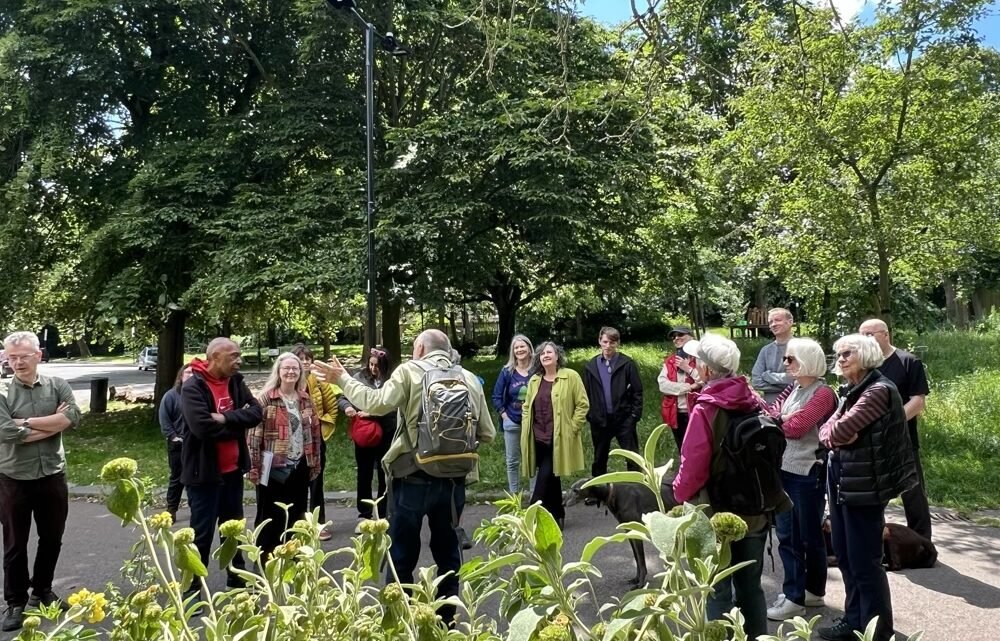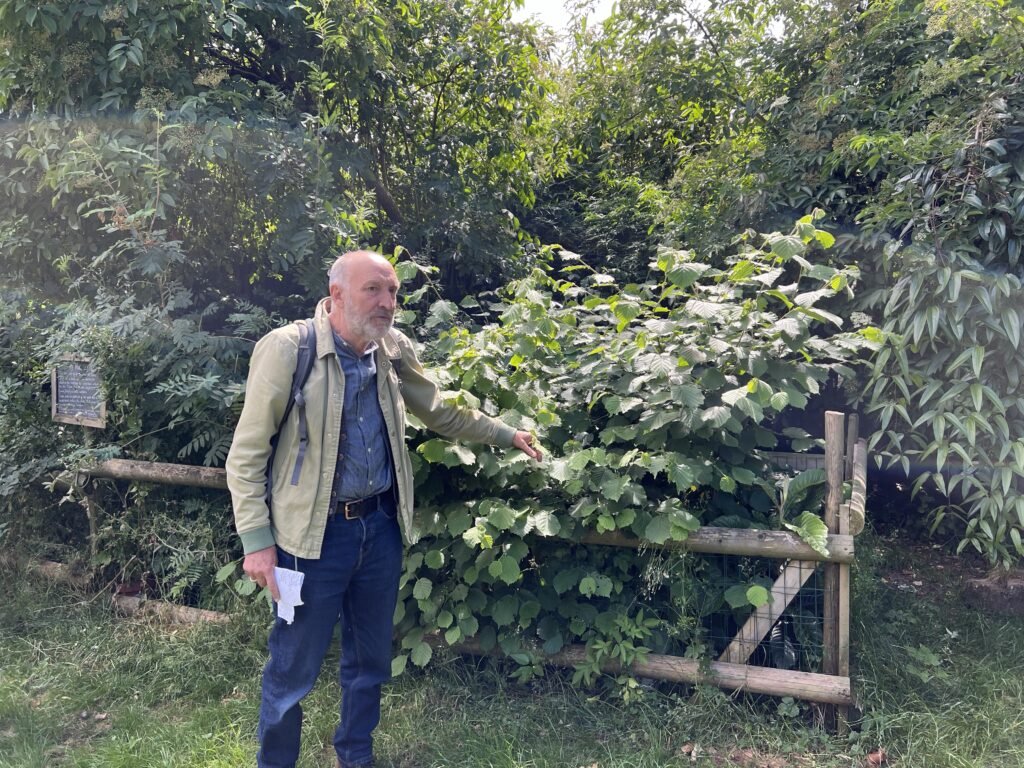
What we learned about the trees of Wray Crescent
We wanted to report back on some of the fascinating things we learned about some of the trees of Wray Crescent during a brilliant hour-long walk through the park with tree expert and author, Bob Gilbert. He told us so many things – what follows are just four of the amazing things we learned.
What we learned about the Elder tree
Walk in from the Thorpedale Road entrance and at the first corner on the left you’ll find a small, slightly twisted seeming tree. That tree is in fact one of the most symbolically meaningful trees in the park and is in fact an Elder tree.
Why is it so important? The Elder is a sacred tree. A belief in the ‘Elder Mother’ existed right through the Middle Ages and up until comparatively recent times. That is because every part of the tree is powerful. Bob explained its divine character, that it represents all the parts of the circle, life and death, good and evil and how it is seen as being protected by Mother Earth itself.
It isn’t just a symbolically important tree.
Not so long ago Elder berries (once they become ripe) were used to make a drink called Rob, and also to make a wine.
Small branches from the tree would also be gently carved into pipes to make music, and the tree is said to possess many healing properties. Elder wood was also carved to create an ancient harp, which the Romans called a Sambuc.
This small tree punches so far above its height, and gives us a direct spiritual, homeopathic, and useful significance that goes back millennia. And it grows on a corner of our park many hundreds of people might walk past every single day. Next time you pass it, think about what it means.

The magical and nutritious Hazel tree
Situated in the tree nursery at the Wray Crescent entrance to the park sits a baby Hazel tree. The Hazel tree has been important to humans since Neolithic times (10,000BC), and in Celtic lore is associated with the goddess Brighid, who brings divine inspiration.
Here are five ways humans have made use of the Hazel tree:
- The nuts are food, offering energy and protein.
- The shells of the nuts, once eaten, make excellent kindling.
- In 18th Century Scotland, the acorns would be ground to create flour for biscuits and bread.
- The catkin flowers of Hazel trees were once drunk as a tea for colds and flu.
- Forked branches of a Hazel tree are still used for dowsing.
The Hazel tree kept entire villages alive in winter, and the tree itself is meant to have its own protective spirit and to act as a guard against evil spirits – even science sees something similar, as eating Hazelnuts as part of a balanced diet can reduce cholesterol. No wonder it was always seen as a protective tree, and its nuts are said to hold so much wisdom.
Wray Crescent’s wonderful Willow trees
Wray Crescent is extraordinarily fortunate to have many Willow trees that absolutely contribute to the character and personality of the entire park. Those are the beautiful silver green trees you see growing beside the basketball court, and that craft so much character as they stand, so elegantly and beautifully, by the building in the big, round and green activity space. Some say these trees together somehow define the soul of our park – but they also encourage so much more biodiversity. Bob told us about the Great Spotted Woodpeckers some of us may have at times heard pecking away in the park, who just love the willow tree. He told us about all the many, many uses made of willows through the ages, from baskets to (somewhat ironically), cricket bats. These beautiful trees give so much to the character of our precious green space.
We learned so much more
Did you know the rarest tree in the park is a Southern Nettle Tree, or that the arc of descent taken by the seed of an Ash Tree was used by Gaudi to inform his design for some of the winding staircases you will find in Barcelona’s Basilica de la Sagrada Familia? Or that Wray Crescent park may well be built above London’s lost river, the Hackney Brook, particularly as a stream was once known to flow beside the Hornsey Road?
Almost thirty of us enjoyed a really fascinating Tolly Talk from Bob.
He sometimes talks about insects, leading a talk with Transport for London that explores the secret world of mosquitoes on the tube (he spoke with The Londonist on this here).
Bob has an equally fascinating book about this and other fascinating natural world mysteries, ‘The Missing Musk: A Casebook of Mysteries from the Natural World’, which we think you might enjoy.
One more thing
Finally, a request. Some people may already know that we are fighting to keep some of the trees in our park alive against a plan from Islington Council that will see some of our trees destroyed to make way for storage. It’s a crazy idea that reduces the reasons for being here – the character of the park – dramatically for no substantial benefit whatsoever.
We ask you, please, to sign a local petition that we support against the plan to kill those trees, and perhaps contact the planning department to protest more (it is still completely fine to contact planning on this). And please help save the trees. The walk was yet another completely free experience provided to the whole community by the Friends of Wray Crescent, please support our work if you are able with a donation.
Thank you for arranging this talk, Bob’s a very engaging speaker. It’s always good to meet up with other members of the community in the park, especially when the talk is about our park!
Wow, so intriguing, sorry to have missed it. Will definitely try and make the next walk. Thank you for the brilliant article Jonny, it was so vivid and palpable, felt like I was there.